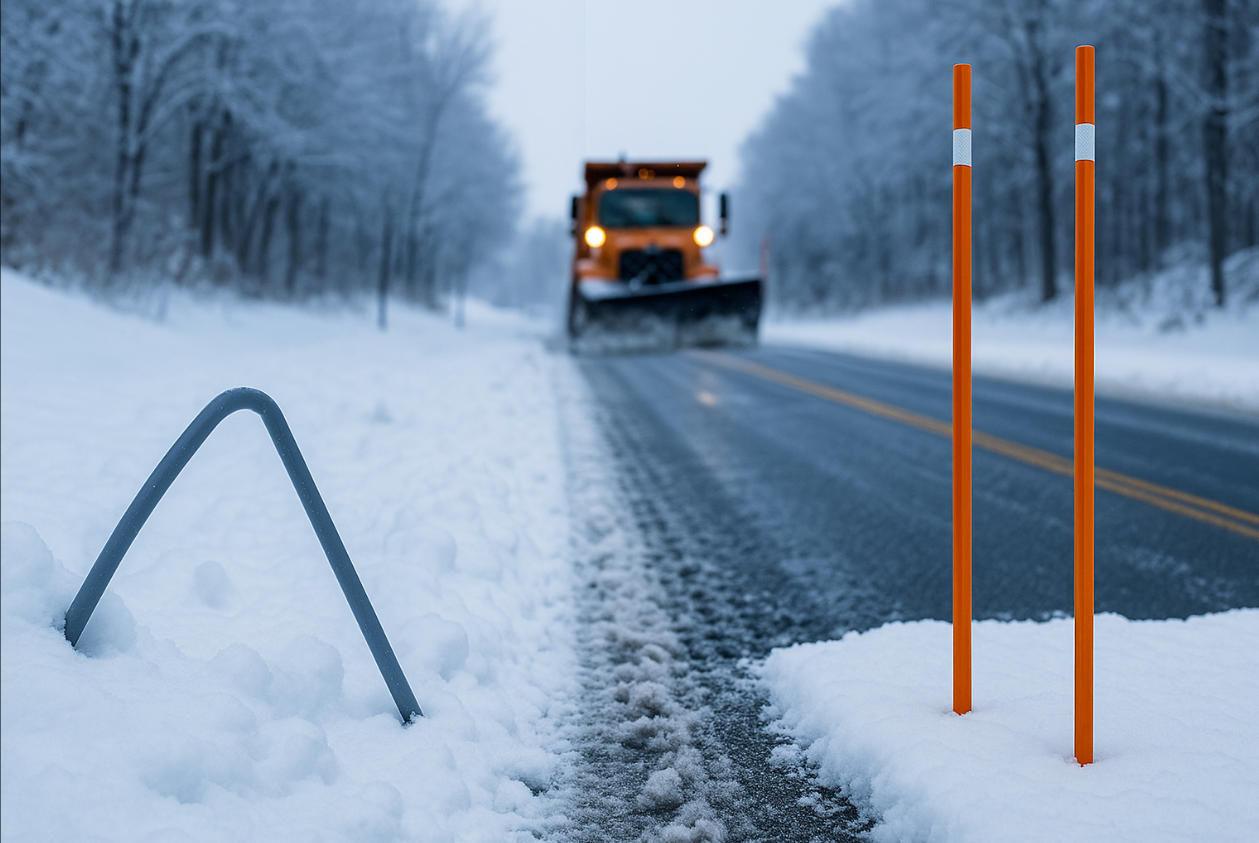Introduction
The first time I swapped brittle wooden laths for heavy duty snow stakes on a ¼-mile distribution-center driveway, I learned the hard way that a pilot hole saves both wrists and stakes. After pre-drilling, the fiberglass rods slid in cleanly and—unlike the cracked PVC I was replacing—were still standing when the April thaw revealed the curb line. That experience kicked off this deep dive into how upgraded stakes compare with ordinary driveway markers and why manufacturers like Unicomposite, an ISO-certified pultrusion specialist, bake longevity into every profile they ship. (unicomposite.com)

heavy duty snow stakes
Understanding Snow Stakes and Markers
What They Are and What They Do
Both products mark pavement edges so plow blades, delivery trucks, and pedestrians stay on course when curbs vanish under snow. The difference is resilience: heavy duty snow stakes are engineered to flex, rebound, and remain visible after repeated impacts, whereas low-cost markers are essentially disposable.
Typical Materials & Construction
| Material | Typical Form | Flex Modulus (psi) | Service Life* |
|---|---|---|---|
| Wood | ¾-in lath | — (brittle) | <1 season |
| PVC | Hollow tube | ~400 000 | 1–2 seasons |
| Steel | Solid rod | 29 000 000 | 3-5 seasons (rust) |
| Pultruded fiberglass/FRP | Solid rod | 5-6 million | 5-7 seasons |
| *Based on 2024–25 field data compiled by Unicomposite and third-party FRP suppliers. |
Durability Factors That Influence Lifespan
Material Strength & Weather Resistance
ASTM D3916 pull tests show a ⅜-in pultruded rod endures ≈1 200 lb of bending load before permanent deformation—eight times more than a same-diameter PVC tube. UV-stabilized resins also limit “fiber bloom,” extending colorfastness beyond five summers. (astm.org)
Manufacturing Processes: Pultrusion vs. Extrusion vs. Injection Molding
Pultrusion draws continuous glass rovings through a heated die, aligning fibers along the stake’s length. Unicomposite’s QA logs document ±2 % dimensional variance across 50 000-ft lots, a tolerance extrusion rarely matches. Extruded plastic markers rely on polymer alone; once the wall crazes, strength plummets.
Installation & Maintenance Practices That Make or Break Longevity
Quick-Look Installation Checklist
- Pre-drill a ½-in hole (or use a stake driver) before ground freeze.
- Seat stake 6–8 in. deep; tap the protective cap, don’t hammer the rod.
- Backfill with thawed aggregate for lateral support.
- Inspect monthly; re-seat any leaners before the next storm.
Following these steps cut my breakage rate to virtually zero over three winters.
Case Study – 3-Year Midwest Field Test
A Midwestern municipality replaced half of its plastic markers with fiberglass stakes on 24 mi of arterial roads:
- Impact survival: Composite stakes resisted 15 mph plow strikes and stayed upright for 5–7 winters.
- Maintenance savings: After season one, fewer than one in ten composites needed replacement versus more than one in four PVC tubes.
- Visibility retention: Reflective collars on composites lost <10 % luminance over three years, thanks to UV-resistant resin.
Expert Insights & Industry Standards
Interview Excerpt: Civil Engineer on Snow-Belt Safety
“When a marker folds, the plow wing becomes your ruler—and taxpayers fund the curb repairs,” says Erin W., P.E., who oversees 200 mi of county roads. “We spec fiberglass stakes because they rebound and, unlike steel, don’t conduct electricity if a downed line touches them.”
Key ASTM/ISO Specifications
- ASTM D3916 – Tensile properties of pultruded rods. (astm.org)
- ASTM D7957 – Structural profiles for civil use.
- ISO 9001:2015 – Quality management certification held by Unicomposite.
Cost-Benefit Analysis for Bulk Buyers
Calculating Total Cost of Ownership (TCO) Over Five Seasons
Assume 500 markers along a logistics hub:
| Option | Unit Price | Replacement Rate | Stake Cost (5 yr) | Labor** | TCO |
|---|---|---|---|---|---|
| Plastic tube | $1.25 | 40 %/yr | $1 750 | $2 500 | $4 250 |
| Heavy duty snow stake | $3.20 | 8 %/yr | $1 728 | $900 | $2 628 |
**Labor @ $30 hr, 10 min install/removal each; Midwest 2025 USD.
ROI Snapshot
Upgrading pays back in ≈2.3 years through lower labor and replacement spend.
How to Select a Heavy Duty Snow Stake Supplier
Quality Certifications, Traceability, Batch Testing
Request ISO 9001 certificates, tensile test sheets, and resin lot traceability. Membership in the American Composites Manufacturers Association (ACMA) signals an additional layer of peer oversight. (acmanet.org)
Customization & Engineering Support—Where Unicomposite Adds Value
Need 5/16-in orange stakes with RFID tags? Unicomposite’s pulwound line adjusts diameter, pigment, and reflective wrap in one pass and can bundle engineering support for utilities or OEMs.
Conclusion
Heavy duty snow stakes made from pultruded fiberglass survive plows, frost heave, and UV far better than commodity markers because fiber alignment, resin chemistry, and process control give them real backbone. Facility managers staring down another storm season can cut breakage, labor, and liability by specifying certified composites—ideally from ISO-approved partners such as Unicomposite. Ready to winter-proof your curbs? Request a custom quote today.
Frequently Asked Questions
- How long do heavy duty snow stakes really last?
Pultruded fiberglass models typically serve 5–7 winters in commercial lots, thanks to impact-absorbing fibers and UV-stable resin. - Can I custom-color stakes to match municipal codes?
Yes. Manufacturers like Unicomposite can add pigments or reflective wraps during pultrusion without affecting strength. - What diameter should I choose for plow routes?
For curbside plowing at 15–20 mph, a ⅜-in (9.5 mm) solid FRP rod balances flex and visibility; heavier ½-in rods suit highway medians. - Do fiberglass stakes conduct electricity if they contact downed lines?
No. FRP is dielectric, adding a safety margin where steel posts would energize. - What certifications prove stake quality?
Look for ISO 9001 quality management, ASTM D3916 tensile testing, and ACMA membership in supplier credentials. (astm.org, acmanet.org)
 info@unicomposite.com
info@unicomposite.com


























